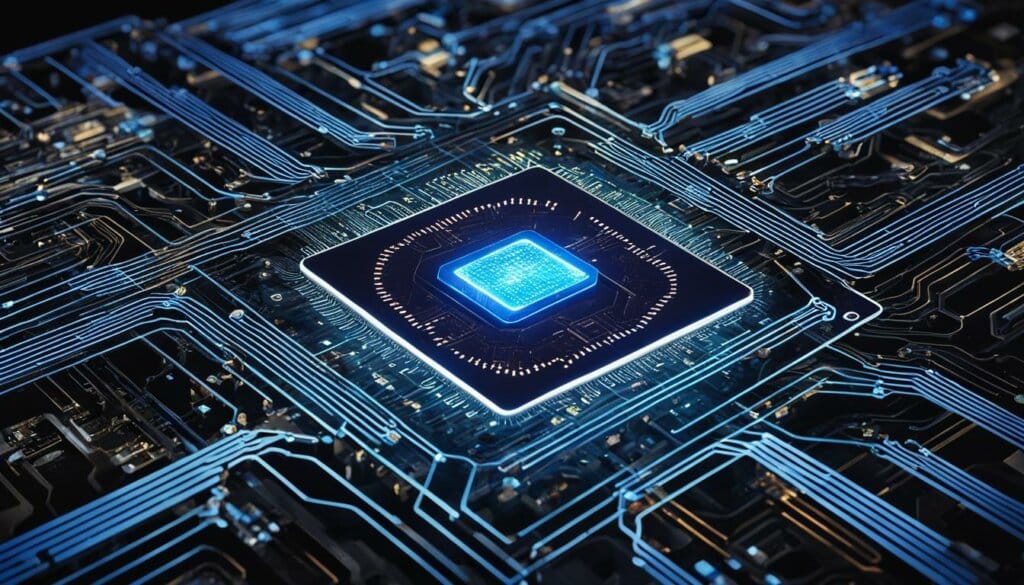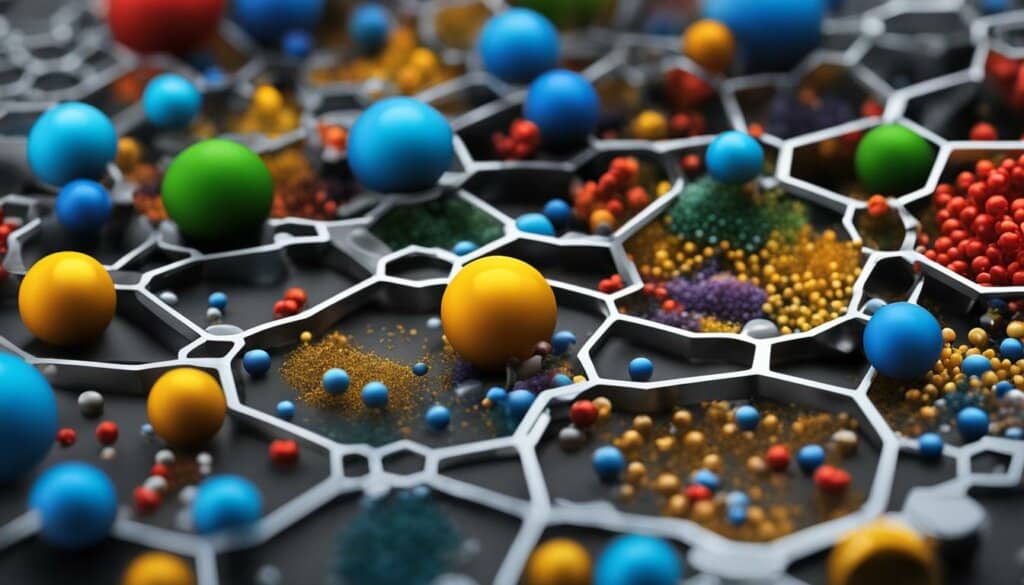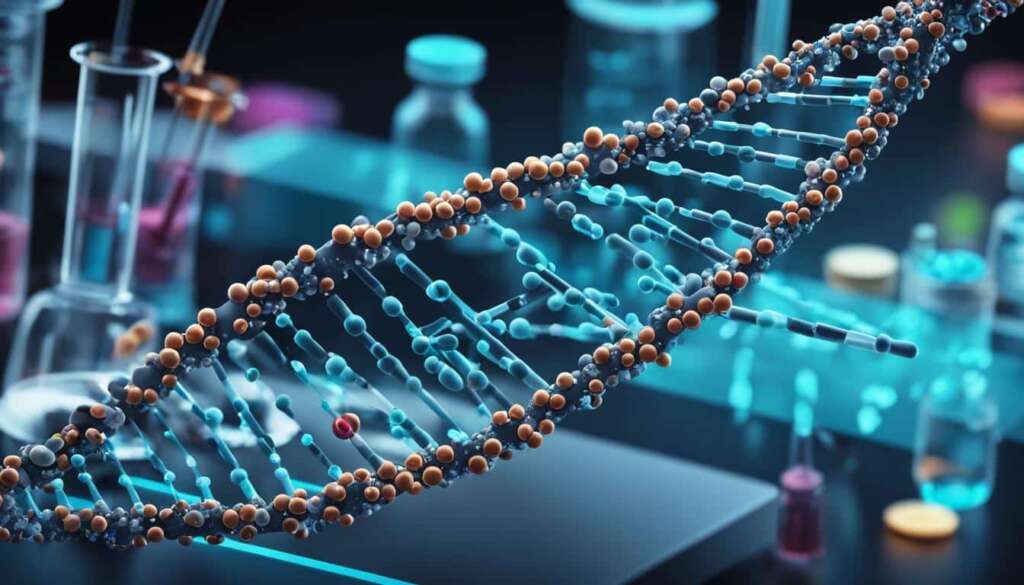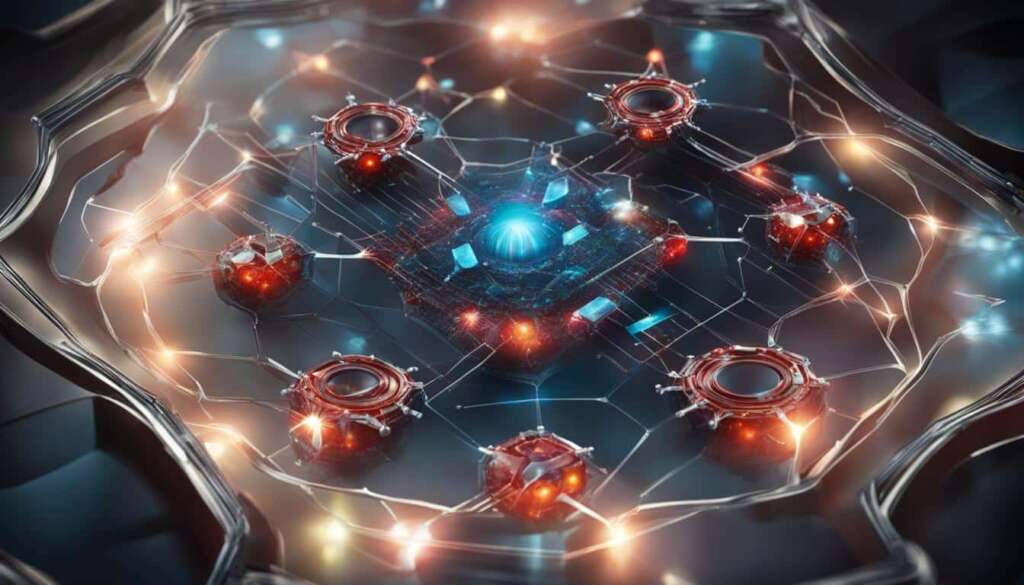Table of Contents
Nanotechnology, the science of manipulating matter at the atomic and molecular scale, holds immense potential for the future. This revolutionary field of study explores the possibilities of creating new materials, devices, and systems with unprecedented capabilities. With advancements taking place rapidly, the future of nanotechnology is filled with exciting opportunities and potential applications that will shape various industries.
Key Takeaways:
- Nanotechnology is a field that focuses on manipulating matter at the atomic and molecular scale
- The future of nanotechnology holds immense potential for advancements in various industries
- Promising applications include wearable fitness technology, self-healing structures, sensors for constant monitoring, efficient data storage and processing, and advancements in medicine and materials science
- Nanotechnology has already made significant contributions in the fight against climate change and in the field of nanomedicine
- As research and development in nanotechnology continue, we can expect even more groundbreaking applications and transformative changes
Doctors inside your body
By scaling down wearable fitness technology, it becomes possible to implant tiny sensors inside the human body. These sensors can capture detailed information about health, allowing doctors to personalize treatment plans. This technology has the potential to revolutionize healthcare and improve patient outcomes.
Wearable fitness technology has become increasingly popular in recent years, with devices like smartwatches and fitness trackers enabling individuals to monitor their activity levels, heart rate, and sleep patterns. However, the next frontier in healthcare lies in taking this technology a step further and implanting sensors directly inside the body.
Implanting sensors allows for more accurate and continuous monitoring of vital signs and health metrics. The data collected by these sensors can provide valuable insights into a patient’s condition and help doctors make more informed decisions regarding their treatment. Additionally, the ability to monitor patients in real-time can lead to early detection of potential health issues and more prompt intervention, ultimately improving patient outcomes.
Imagine a future where individuals with chronic conditions, such as diabetes or heart disease, have tiny sensors implanted to constantly monitor their blood glucose levels or heart function. Instead of relying on periodic check-ups or sporadic measurements, doctors would have access to real-time data, allowing for personalized treatment plans tailored to each patient’s specific needs.
Personalized treatment is a key benefit of wearable fitness technology that has been implanted inside the body. This technology has the potential to transform healthcare by moving away from a one-size-fits-all approach and towards treatments that are tailored to an individual’s unique requirements and condition.
The use of implantable sensors in healthcare is not limited to chronic conditions alone. They can also have applications in monitoring post-operative care, tracking the progress of patients undergoing rehabilitation, and even assisting in the early detection of diseases such as cancer.
The ability to track a patient’s progress in real-time through implanted sensors allows doctors to make adjustments to their treatment plans as needed. This real-time monitoring can lead to more effective interventions, shorter recovery times, and improved patient satisfaction.
However, the implementation of implantable sensors in healthcare is not without challenges. Privacy and security concerns, surgical procedures to implant the sensors, and the integration of sensor data into existing healthcare systems are among the factors that need to be carefully addressed.
Overall, the integration of wearable fitness technology by implanting sensors inside the body has the potential to revolutionize healthcare. From personalized treatment plans to real-time monitoring and improved patient outcomes, this technology opens up new possibilities for the future of medicine.
| Benefits | Challenges |
|---|---|
| 1. Personalized treatment plans tailored to individual needs | 1. Privacy and security concerns |
| 2. Real-time monitoring for early detection and intervention | 2. Surgical procedures for sensor implantation |
| 3. Improved patient outcomes and satisfaction | 3. Integration of sensor data into existing healthcare systems |
Sensors, sensors, everywhere
Nanotechnology has paved the way for the development of smaller, more complex, and energy-efficient nanosensors. These sensors can be placed at multiple points over critical infrastructure, such as bridges, aircraft, and nuclear power plants, to constantly monitor their performance. This constant monitoring can help ensure the smooth operation of vital systems and prevent failures.
With nanosensors, critical infrastructure can be equipped with advanced monitoring capabilities that provide real-time data on structural integrity, performance, and potential risks. These tiny sensors have the ability to capture and transmit essential information, enabling engineers and operators to identify anomalies, monitor stress levels, and predict maintenance needs.
The key advantage of nanosensors in critical infrastructure lies in their size and versatility. Being incredibly small, they can be easily integrated into various components and structures without causing disruptions. Their energy efficiency allows for long-term, continuous monitoring, reducing the need for frequent maintenance and inspections.
For example, in bridges, nanosensors can be embedded in concrete to monitor the structural health and detect any signs of deterioration or stress. In aircraft, they can be installed in key components like wings and engines to ensure optimal performance and detect any potential failures. In nuclear power plants, nanosensors can play a crucial role in monitoring radiation levels, temperature, and other critical parameters.
Benefits of Nanosensors in Critical Infrastructure
Nanosensors offer several benefits when used in critical infrastructure:
- Early detection of structural issues
- Enhanced safety and reliability
- Real-time data for timely decision-making
- Cost-effective maintenance and repairs
- Potential for predictive maintenance
The continuous monitoring provided by nanosensors ensures that potential issues are identified before they escalate into major failures, preventing catastrophic incidents and minimizing downtime. This proactive approach to maintenance and repair can significantly improve the lifespan and performance of critical infrastructure.
Challenges and Future Developments
While the use of nanosensors in critical infrastructure offers immense potential, there are challenges that need to be addressed. These challenges include the development of robust and reliable sensor systems, data management and analysis, and integration with existing infrastructure.
Researchers and engineers are working towards overcoming these challenges and further advancing nanosensor technology. Future developments may include improved data analytics algorithms, wireless communication capabilities, and self-powered nanosensors that can harvest energy from their environment.
As nanotechnology continues to evolve, the integration of nanosensors in critical infrastructure will become increasingly prevalent, ensuring the continuous monitoring and optimal performance of essential systems.

Self-healing structures
Nanotechnology has unlocked the potential to create self-healing materials through the manipulation of materials at the nanoscale. These innovative materials possess unique properties that enable them to “heal” themselves when damaged or worn, effectively preventing small fractures from escalating into larger, more problematic cracks. The development of self-healing materials has far-reaching applications across numerous industries, ranging from aerospace to microelectronics.
In practical terms, imagine an aircraft cockpit coated with nanotechnology coatings that can repair small scratches and abrasions automatically, ensuring the integrity of the structure and reducing maintenance costs. Similarly, self-healing materials can enhance the durability and reliability of microelectronics, enabling longer product lifespans and reducing the need for frequent replacements.
Self-healing materials work by incorporating nanoscale particles or capsules within the material matrix. When a crack or damage occurs, these particles are released, react with the surrounding environment, and fill the voids, restoring the material’s integrity. This self-repairing process can occur repeatedly, ensuring prolonged functionality and longevity of the material.
One of the significant advantages of self-healing materials is their potential to extend the lifespan and improve the safety of critical infrastructure. For example, bridges and buildings can benefit from nanotechnology coatings that possess self-healing properties, preventing minor cracks from developing into major structural issues. By constantly monitoring and repairing themselves, these structures can withstand environmental stresses and maintain their structural integrity over extended periods.
Moreover, self-healing materials have the potential to revolutionize the field of medicine. Researchers are exploring the use of nanotechnology to develop self-healing polymers for tissue regeneration. These biomaterials have the ability to repair damaged tissues, potentially leading to advances in wound healing, organ repair, and even the development of artificial organs.
In summary, nanotechnology has introduced the concept of self-healing materials, which possess remarkable repair capabilities at the nanoscale. These materials have tremendous potential across a wide range of industries, from aerospace and electronics to infrastructure and healthcare. The ability to heal themselves offers enhanced durability, reduced maintenance costs, and improved safety, paving the way for a future where structures can repair themselves and materials can regenerate damaged tissues.
Making Big Data Possible
The proliferation of sensors in various industries will generate vast amounts of data. Nanotechnology is revolutionizing the way we handle and analyze this data, with advancements in nanotechnology memory, ultra-dense storage, and efficient processing. These developments are essential for harnessing the power of big data and unlocking its potential.
Nanotechnology memory plays a crucial role in storing the massive amounts of data generated by sensors. Traditional storage methods are limited in capacity and efficiency, but nanotechnology offers a solution by enabling the creation of ultra-dense memory. This allows for the storage of vast amounts of information in a smaller physical space, maximizing storage capacity and minimizing energy consumption.
Ultra-Dense Storage
Nanotechnology enables the development of ultra-dense storage solutions that can accommodate the exponential growth in data. By manipulating materials at the nanoscale, scientists can create storage media with higher data densities, surpassing the limits of traditional storage technologies. These advancements in ultra-dense storage provide a scalable solution to meet the increasing demand for data storage in the digital age.
Efficient processing is another critical aspect of managing big data. Nanotechnology-inspired computer architectures leverage nanoscale components and designs to process, encrypt, and communicate data efficiently. These architectures optimize data flow, minimize latency, and enhance overall system performance, ensuring smooth data processing even with large data sets.
Efficient Processing
“The efficient processing of big data is paramount in today’s data-driven world. Nanotechnology offers innovative solutions that allow for faster and more reliable data processing, enabling us to make sense of complex data sets and extract valuable insights.” – Dr. Sarah Thompson, Data Science Expert
Nanotechnology-driven processing solutions are not only efficient but also reliable. By leveraging nanotechnology’s inherent stability and control over nanoscale components, these processing systems can handle data-intensive tasks without compromising on accuracy or security. This is crucial in industries such as finance, healthcare, and research, where reliable data processing is essential for decision-making and analysis.
The advancements in nanotechnology memory, ultra-dense storage, and efficient processing contribute to the effective management and utilization of big data. With these technologies, industries can harness the potential of big data to drive innovation, improve processes, and gain valuable insights that lead to better decision-making.

Tackling Climate Change
Nanotechnology is already playing a significant role in addressing the pressing issue of climate change. It has paved the way for advancements in nanotechnology batteries and energy storage, which are vital components of renewable energy systems. These technological breakthroughs have the potential to transform the way we generate, store, and utilize energy.
One area where nanotechnology has made notable contributions is in the development of batteries with improved energy storage capabilities for electric cars. These nanotechnology batteries offer higher power densities, longer cycle life, and faster charging times, which overcome some of the limitations of conventional batteries. By enhancing the energy storage capacity of electric vehicles, nanotechnology plays a crucial role in reducing greenhouse gas emissions and transitioning towards a more sustainable transportation sector.
Moreover, nanotechnology has also significantly enhanced the efficiency of solar panels. Through nanoscale engineering, scientists have created materials with a greater surface area, enabling solar panels to capture and convert more sunlight into usable energy. This increased efficiency not only makes solar energy more viable but also reduces the reliance on fossil fuels, mitigating the adverse environmental impacts associated with traditional energy sources.
The Full Potential of Nanotechnology in Energy
Aside from batteries and solar panels, nanotechnology enables the creation of materials with unique properties that facilitate more efficient energy storage and generation. These materials have a significantly larger surface area-to-volume ratio, allowing for greater storage and conversion of energy. For instance, nanotechnology-inspired catalysts can enhance the performance of fuel cells, improving their energy conversion efficiency and making them more sustainable alternatives for power generation.
Nanotechnology research is also exploring the potential of harnessing energy from diverse sources with high conversion efficiency. Scientists are investigating the development of nanogenerators capable of converting mechanical energy from movement or vibrations into electrical energy. This technology can potentially power small electronic devices, sensors, or even charge wearable devices, further reducing our dependence on conventional energy sources.
By embracing nanotechnology, we can unlock innovative solutions for addressing climate change and transitioning towards a cleaner and sustainable future. The ability to store and generate energy more efficiently is crucial for realizing the full potential of renewable energy sources, such as solar and wind power. Nanotechnology enables us to optimize energy systems, reduce carbon emissions, and pave the way for a greener and more sustainable world.
Materials Science
Nanotechnology has revolutionized materials science through the creation of nano materials. These materials, engineered at the nano-scale, offer exceptional properties that make them stronger, lighter, and more durable compared to traditional materials.
By manipulating materials at the nano level, scientists have been able to enhance the structural integrity of various substances. Nano materials have unique properties that enable them to withstand greater forces, making them stronger than their macro-scale counterparts.
Additionally, nano materials are significantly lighter in weight, making them ideal for applications where weight reduction is crucial. For example, in the aerospace industry, the use of nano materials in aircraft construction has led to increased fuel efficiency and improved overall performance.
Furthermore, nano materials possess superior durability, enabling them to withstand harsh conditions and prolonged exposure to wear and tear. These materials have demonstrated exceptional resistance to corrosion, erosion, and degradation.
Improved Conduction and Electrical Properties
Nano materials also exhibit enhanced electrical and thermal conduction properties. These materials have improved electrical conductivity, making them efficient conductors of electricity. This characteristic is beneficial in various applications such as electronics, where nano materials enable the development of smaller, more efficient devices.
Moreover, nano materials have superior thermal conductivity, allowing them to efficiently transport heat. This property is advantageous in fields such as heat management in electronic devices, improving overall performance and preventing overheating.
“The use of nano materials in various industries is a game-changer. These materials possess extraordinary strength, reduced weight, and impressive durability. With their unique properties, nano materials have the potential to transform industries such as construction, transportation, and electronics.”
To illustrate the superior properties of nano materials, consider the following table:
| Material | Strength | Weight | Durability |
|---|---|---|---|
| Titanium Alloy | Very High | Heavy | Moderate |
| Nano Composite | Exceptional | Lightweight | Excellent |

As demonstrated in the table above, nano materials outperform traditional materials in terms of strength, weight, and durability. The comparison clearly highlights the potential of nano materials to revolutionize industries by enabling the development of adaptable, self-intelligent, and high-performance materials.
Nanomedicine
Nanomedicine has already made significant advances, revolutionizing the field of medicine. Nanoparticles are being used in diagnostic tools, imaging techniques, drug delivery systems, and tissue engineering.
One of the key applications of nanomedicine is in diagnostic tools. Nanoparticles can be engineered to detect and bind to specific molecules or biomarkers in the body, allowing for early detection of diseases such as cancer or infections. These nanoparticles can be used in various diagnostic methods, including blood tests, imaging techniques, and biosensors, providing accurate and timely information for healthcare professionals to make informed decisions.
Furthermore, nanotechnology plays a crucial role in improving imaging techniques. Nanoparticles can be used as contrast agents to enhance the visibility of specific tissues or cells in medical imaging, such as magnetic resonance imaging (MRI) or computed tomography (CT) scans. This improved imaging allows for better visualization of anatomical structures, early disease detection, and monitoring of treatment progress.
Nanotechnology’s impact on drug delivery systems is another significant development in nanomedicine. Nanoparticles can be designed to carry and deliver medications directly to targeted cells or tissues in the body. This targeted drug delivery system offers several advantages, including reduced side effects, increased drug efficacy, and improved patient compliance. These nanoparticles can be engineered to release the medication at a controlled rate, ensuring optimal therapeutic outcomes.
Tissue engineering is also benefiting from nanotechnology. By utilizing nanomaterials and nanoscale fabrication techniques, researchers can create scaffolds that mimic the natural extracellular matrix, providing a conducive environment for tissue regeneration. These engineered tissues hold immense potential for applications such as organ transplantation, wound healing, and even the development of prosthetics and bionic organs.
Researchers are continuously exploring the potential of nanotechnology in gene sequencing and genetic engineering. Nanoparticles can be used to deliver genetic material, such as DNA or RNA, to specific cells, enabling precise gene editing and manipulation. This advancement in nanotechnology holds promising prospects for eradicating hereditary illnesses and regenerating tissues and organs.
To visualize the impact of nanomedicine on various medical applications, refer to the table below:
| Medical Application | Nanotechnology Contribution |
|---|---|
| Diagnostic Tools | Nanoparticles for early disease detection |
| Imaging Techniques | Nanoparticles as contrast agents for enhanced visibility |
| Drug Delivery Systems | Targeted delivery of medications |
| Tissue Engineering | Nanomaterials for scaffolds and tissue regeneration |
| Gene Sequencing and Genetic Engineering | Nanoparticles for precise gene editing |
Overall, nanotechnology’s integration into medicine has opened up new possibilities for diagnosis, treatment, and regenerative therapies. As researchers continue to push the boundaries of nanomedicine, we can expect further advancements that will transform healthcare and improve patient outcomes.
Conclusion
The future of nanotechnology is filled with incredible potential and limitless possibilities. As advancements in nanotechnology continue to unfold, various industries, including healthcare, energy, construction, and computing, will be profoundly impacted. Nanotechnology offers an unparalleled opportunity to shape our future by enabling innovative solutions that enhance efficiency, sustainability, and overall quality of life.
With ongoing research and development in nanotechnology, we can anticipate a wave of groundbreaking applications and transformative changes in the years to come. These advancements hold the promise of revolutionizing healthcare with personalized treatments and wearable sensors that provide valuable insights into our well-being.
Moreover, the integration of nanosensors into critical infrastructure will ensure constant monitoring, enhancing the performance and resilience of essential systems such as bridges, aircraft, and nuclear power plants. Additionally, the development of self-healing materials and ultra-dense storage enabled by nanotechnology will not only have a profound impact on industries like aerospace and microelectronics but also contribute to the fight against climate change.
As we venture into this exciting future, it is clear that nanotechnology will continue to unlock new frontiers and fuel innovation. The possibilities are truly limitless, and we can eagerly anticipate a future where nanotechnology plays a pivotal role in driving progress and transforming the world as we know it.
FAQ
What is nanotechnology?
Nanotechnology is a field of science and technology that involves manipulating matter at the nanoscale, which is the scale of atoms and molecules. It involves creating and manipulating materials, devices, and systems at the nanometer scale to achieve unique properties and functionalities.
What are the potential applications of nanotechnology?
Nanotechnology has the potential to revolutionize various industries such as healthcare, energy, construction, and computing. It can be used for personalized medicine, improving the efficiency of energy storage and generation, creating stronger and lighter materials, and developing advanced computing systems, among many other applications.
How can nanotechnology be used in healthcare?
Nanotechnology can be used in healthcare in various ways. It enables the development of wearable fitness technology and implanting sensors inside the human body to monitor health and personalize treatment plans. It also facilitates targeted drug delivery, improved imaging techniques, and the development of prosthetics and bionic organs.
How can nanotechnology improve the monitoring of critical infrastructure?
Nanotechnology enables the development of nanosensors that can be placed at multiple points over critical infrastructure such as bridges, aircraft, and nuclear power plants. These sensors constantly monitor the performance of these structures, ensuring their smooth operation and helping prevent failures.
What are self-healing structures?
Self-healing structures are materials that can repair themselves when damaged or worn. Nanotechnology allows the creation of materials at the nanoscale that have properties enabling them to “heal” and prevent small fractures from turning into larger, more problematic cracks.
How does nanotechnology contribute to handling big data?
Nanotechnology helps create ultra-dense memory that can store large amounts of data generated by the proliferation of sensors in various industries. It also enables nanotechnology-inspired computer architectures that can process, encrypt, and communicate data efficiently without compromising reliability.
What role does nanotechnology play in the fight against climate change?
Nanotechnology contributes to the development of batteries that can store more energy for electric cars and improves the efficiency of solar panels. It enables the creation of materials with a greater surface area, allowing for more efficient energy storage and generation. Nanotechnology research also explores harnessing energy from movement, light, temperature variations, and other sources with high conversion efficiency.
How does nanotechnology revolutionize materials science?
Nanotechnology enables the creation of stronger, lighter, and more durable materials through nano-scale engineering. These materials have unique properties that make them more robust, more conductive, and better electrical conductors. They have the potential to transform industries such as construction and transportation by enabling the development of adaptable, self-intelligent, and high-performance materials.
What are the advancements in nanomedicine?
Nanomedicine has made significant advances in various areas of healthcare. Nanoparticles are being used in diagnostic tools, imaging techniques, drug delivery systems, and tissue engineering. Nanotechnology enables targeted drug delivery, improved imaging, and the development of prosthetics and bionic organs. It also holds potential in gene sequencing and genetic engineering to eradicate hereditary illnesses and regenerate tissues and organs.







